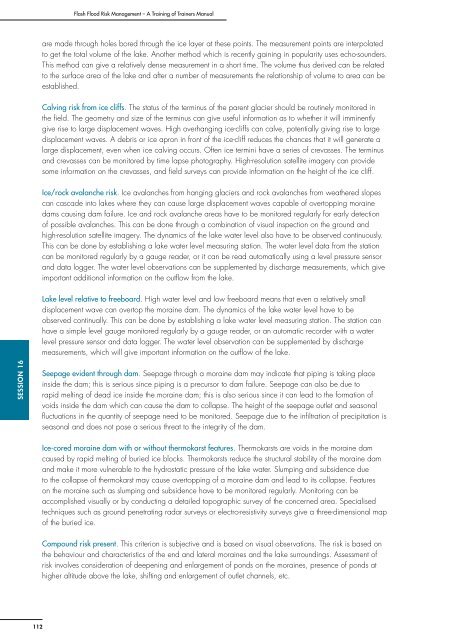Flash Flood Risk Management â A Training of Trainers ... - ReliefWeb
Flash Flood Risk Management â A Training of Trainers ... - ReliefWeb
Flash Flood Risk Management â A Training of Trainers ... - ReliefWeb
Create successful ePaper yourself
Turn your PDF publications into a flip-book with our unique Google optimized e-Paper software.
<strong>Flash</strong> <strong>Flood</strong> <strong>Risk</strong> <strong>Management</strong> – A <strong>Training</strong> <strong>of</strong> <strong>Trainers</strong> Manual<br />
are made through holes bored through the ice layer at these points. The measurement points are interpolated<br />
to get the total volume <strong>of</strong> the lake. Another method which is recently gaining in popularity uses echo-sounders.<br />
This method can give a relatively dense measurement in a short time. The volume thus derived can be related<br />
to the surface area <strong>of</strong> the lake and after a number <strong>of</strong> measurements the relationship <strong>of</strong> volume to area can be<br />
established.<br />
Calving risk from ice cliffs. The status <strong>of</strong> the terminus <strong>of</strong> the parent glacier should be routinely monitored in<br />
the field. The geometry and size <strong>of</strong> the terminus can give useful information as to whether it will imminently<br />
give rise to large displacement waves. High overhanging ice-cliffs can calve, potentially giving rise to large<br />
displacement waves. A debris or ice apron in front <strong>of</strong> the ice-cliff reduces the chances that it will generate a<br />
large displacement, even when ice calving occurs. Often ice termini have a series <strong>of</strong> crevasses. The terminus<br />
and crevasses can be monitored by time lapse photography. High-resolution satellite imagery can provide<br />
some information on the crevasses, and field surveys can provide information on the height <strong>of</strong> the ice cliff.<br />
Ice/rock avalanche risk. Ice avalanches from hanging glaciers and rock avalanches from weathered slopes<br />
can cascade into lakes where they can cause large displacement waves capable <strong>of</strong> overtopping moraine<br />
dams causing dam failure. Ice and rock avalanche areas have to be monitored regularly for early detection<br />
<strong>of</strong> possible avalanches. This can be done through a combination <strong>of</strong> visual inspection on the ground and<br />
high-resolution satellite imagery. The dynamics <strong>of</strong> the lake water level also have to be observed continuously.<br />
This can be done by establishing a lake water level measuring station. The water level data from the station<br />
can be monitored regularly by a gauge reader, or it can be read automatically using a level pressure sensor<br />
and data logger. The water level observations can be supplemented by discharge measurements, which give<br />
important additional information on the outflow from the lake.<br />
Lake level relative to freeboard. High water level and low freeboard means that even a relatively small<br />
displacement wave can overtop the moraine dam. The dynamics <strong>of</strong> the lake water level have to be<br />
observed continually. This can be done by establishing a lake water level measuring station. The station can<br />
have a simple level gauge monitored regularly by a gauge reader, or an automatic recorder with a water<br />
level pressure sensor and data logger. The water level observation can be supplemented by discharge<br />
measurements, which will give important information on the outflow <strong>of</strong> the lake.<br />
session 16<br />
Seepage evident through dam. Seepage through a moraine dam may indicate that piping is taking place<br />
inside the dam; this is serious since piping is a precursor to dam failure. Seepage can also be due to<br />
rapid melting <strong>of</strong> dead ice inside the moraine dam; this is also serious since it can lead to the formation <strong>of</strong><br />
voids inside the dam which can cause the dam to collapse. The height <strong>of</strong> the seepage outlet and seasonal<br />
fluctuations in the quantity <strong>of</strong> seepage need to be monitored. Seepage due to the infiltration <strong>of</strong> precipitation is<br />
seasonal and does not pose a serious threat to the integrity <strong>of</strong> the dam.<br />
Ice-cored moraine dam with or without thermokarst features. Thermokarsts are voids in the moraine dam<br />
caused by rapid melting <strong>of</strong> buried ice blocks. Thermokarsts reduce the structural stability <strong>of</strong> the moraine dam<br />
and make it more vulnerable to the hydrostatic pressure <strong>of</strong> the lake water. Slumping and subsidence due<br />
to the collapse <strong>of</strong> thermokarst may cause overtopping <strong>of</strong> a moraine dam and lead to its collapse. Features<br />
on the moraine such as slumping and subsidence have to be monitored regularly. Monitoring can be<br />
accomplished visually or by conducting a detailed topographic survey <strong>of</strong> the concerned area. Specialised<br />
techniques such as ground penetrating radar surveys or electro-resistivity surveys give a three-dimensional map<br />
<strong>of</strong> the buried ice.<br />
Compound risk present. This criterion is subjective and is based on visual observations. The risk is based on<br />
the behaviour and characteristics <strong>of</strong> the end and lateral moraines and the lake surroundings. Assessment <strong>of</strong><br />
risk involves consideration <strong>of</strong> deepening and enlargement <strong>of</strong> ponds on the moraines, presence <strong>of</strong> ponds at<br />
higher altitude above the lake, shifting and enlargement <strong>of</strong> outlet channels, etc.<br />
112

















